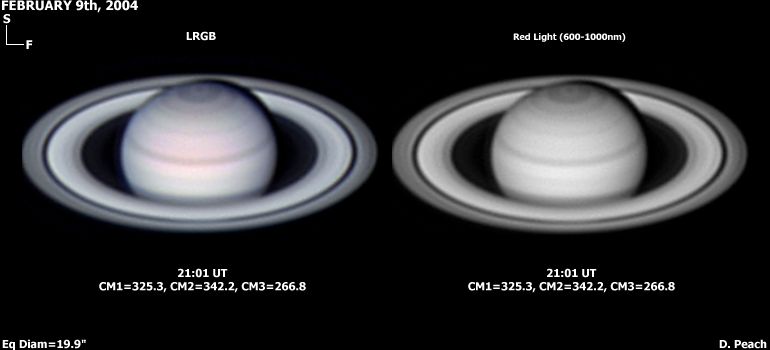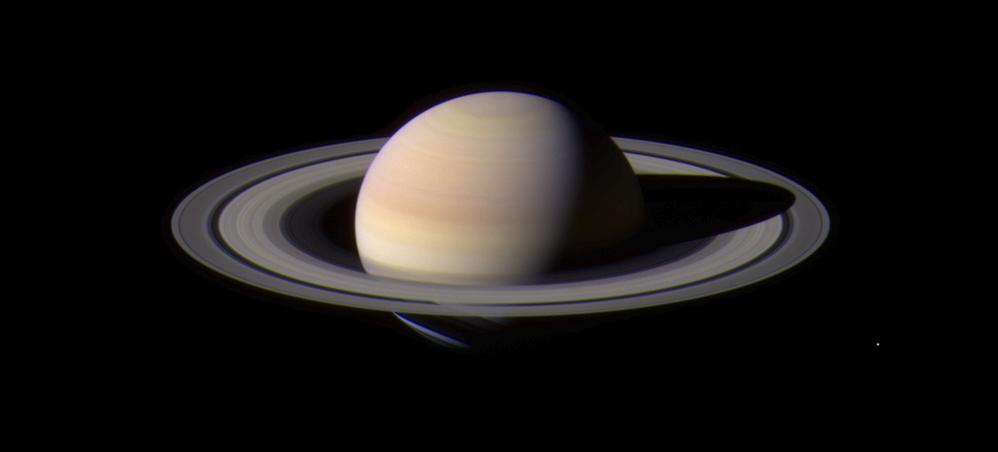|
Damian Peach (235mm Celestron SCT:ATK-1HS CCD)
|

9.25" (23.5 cm) Celestron SCT @ f/29.4 ATK-1HS CCD camera.
Seeing fair-good (Pickering 5-8.)
Transparency variable w/ frequent stratus (1.0-5.0mag.) No wind. Light dew.
Eq Diam=19.9" Altitude=50-61degs.
[Damian Peach: Loudwater, Buckinghamshire, UK.]
|
|
The Cassini-Huygens mission
|
South up

Original image Tiff North UP 998X1023 400kB
tiff 2992kB 1024X1024 Original picture
The narrow angle camera onboard the Cassini spacecraft took a series of exposures of Saturn and its
rings and moons on February 9, 2004, which were composited to create this stunning, color image.
At the time, Cassini was 69.4 million kilometers (43.1 million miles) from Saturn, less than half
the distance from Earth to the Sun.
The image contrast and colors have been slightly enhanced to aid visibility. The smallest features
visible in this image are approximately 540 kilometers across (336 miles).
Fine details in the rings and atmosphere are beginning to emerge, and will grow in sharpness and clarity over the coming months.
The optical thickness of Saturn's B (middle) ring and the comparative translucence of the A (outer) ring,
when seen against the planet, are now apparent. Subtle color differences in the finely banded Saturnian
atmosphere, as well as structure within the diaphanous, inner C ring can be easily seen.
Noticeably absent are the ghostly spoke-like dark markings in Saturn's B ring, first discovered by NASA's
Voyager spacecraft on approach to the planet 23 years ago.
The icy moon Enceladus (520 kilometers or 323 miles across) is faintly visible on the left in the image.
Its brightness has been increased seven times relative to the planet. Cassini will make several very close
approaches to Enceladus, returning images in which features as small as 50 meters (165 feet) or less will be detectable.
The composite image signals the start of Cassini's final approach to the ringed planet and the beginning
of monitoring and data collection on Saturn and its environment.
This phase of the mission will continue until Cassini enters orbit around Saturn on July 1, 2004.
The Cassini-Huygens mission is a cooperative project of NASA, the European Space Agency and the Italian Space Agency.
The Jet Propulsion Laboratory, a division of the California Institute of Technology in Pasadena, manages the
Cassini mission for NASA's Office of Space Science, Washington, D.C.
Image Credit:
NASA/JPL/Space Science Institute
2004/02/09 カッシーニ土星周回探査機に搭載された狭角度カメラは、土星リング衛星月の一連の撮影を行った。
この驚異的なカラーイメージを作成するために組まれた。距離は6940万km。色彩は少し強調してあります。
この画像の解像力は約540kmです。右側にエンケラズスが写っている。
(撮影時刻はわかりませんでした。)
Image Credit:
NASA/JPL/Space Science Institute
[NASA/JPL/Space Science Institute]
 ALPO-Japan Latest ALPO-Japan Latest

 Saturn Section Saturn Section
|





 ALPO-Japan Latest
ALPO-Japan Latest

 Saturn Section
Saturn Section